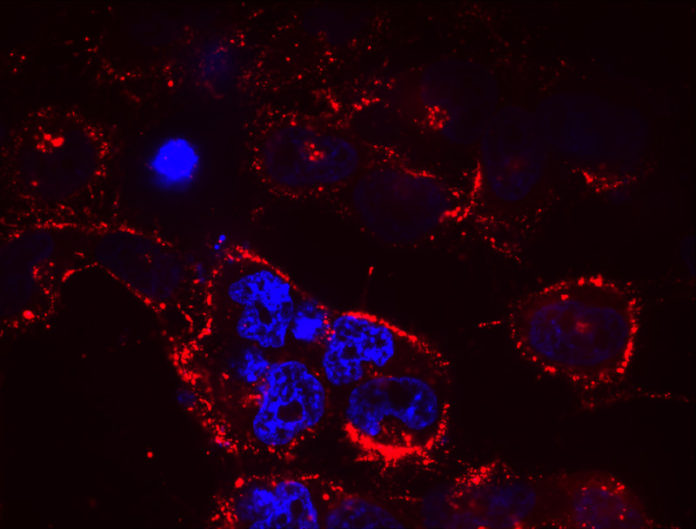
Small RNA molecules, including microRNAs (miRNAs) and small interfering RNAs (siRNAs), offer tremendous potential for new therapeutic agents to inhibit cancer cell growth. However, delivering these small RNAs to solid tumors remains a significant challenge, as the RNAs must target the correct cells and avoid being broken down by enzymes in the body. To date, most work in this area has focused on delivery to the liver, where targeting is relatively straightforward.
This week in the journal Proceedings of the National Academy of Sciences, researchers at the Koch Institute for Integrative Cancer Research at MIT now report that they have successfully delivered small RNA therapies in a clinically relevant mouse model of lung cancer to slow and shrink tumor growth. Their research offers promise for personalized RNA combination therapies to improve therapeutic response.
Using the “KP” mouse model, in which a mutant form of the oncogene KRAS is activated and tumor suppressor gene p53 is deleted, researchers injected mice with RNA-carrying nanoparticles. This mouse model recapitulates many of the hallmarks of human lung cancer and is often used in preclinical trials. It was originally developed in the laboratory of Koch Institute Director and David H. Koch Professor of Biology Tyler Jacks, who is co-senior author of this paper.
The nanoparticles are made of a small polymer lipid conjugate, and unlike most liver-targeting nanoparticles, they preferentially target the lung and are well tolerated in the body. They were developed in the laboratories of co-senior author Daniel G. Anderson, Samuel A. Goldblith Professor of Applied Biology, Associate Professor of Chemical Engineering and Institute of Medical Engineering and Science; and author Robert Langer, the David H. Koch Institute Professor.
In this study, researchers tested the nanoparticle delivery system with different payloads of therapeutic RNA. They found that delivery of miR-34a, a p53-regulated miRNA, slowed tumor growth, as did delivery of siKRAS, a KRAS-targeting siRNA. Next, researchers treated mice with both miR-34a and siKRAS in the same nanoparticle. Instead of just slowing tumor growth, this combination therapy caused tumors to regress and shrink to about 50 percent of their original size.
Researchers then compared mouse survival time among four treatment options — providing no treatment; treating with cisplatin, a small-molecule, standard-care chemotherapy drug; treating with nanoparticles carrying both miR-34a and siKRAS; and treating with both cisplatin and the nanoparticles. They found that the nanoparticle treatment extended life just as well as the cisplatin treatment, and furthermore, that the combination therapy of the nanoparticles and cisplatin together extended life by about an additional 25 percent.
This early example of RNA combination therapy demonstrates the potential of developing personalized cancer treatments. With efficient delivery of therapeutic RNA, any individual small RNA or combination of RNAs could be deployed to regulate the genetic mutations underlying a given patient’s cancer. Furthermore, these RNA therapies could be combined with more traditional drug therapies for an enhanced effect.
“Small RNA therapy hold great promise for cancer,” says Jacks. “It is widely appreciated that the major hurdle in this field is efficient delivery to solid tumors outside of the liver, and this work goes a long way in showing that this is achievable.”
“RNA therapies are very flexible and have a lot of potential, because you can design them to treat any type of disease by modifying gene expression very specifically,” says James Dahlman, a graduate student in Anderson’s and Langer’s laboratories who, along with senior postdoctoral associate Wen Xue of Jacks’ laboratory, is co-first author of the paper. “We took the best mouse model for lung cancer we could find, we found the best nanoparticle we could use, and for one of the first times, we demonstrate targeted RNA combination therapy in a clinically-relevant model of lung cancer.”
This investigation typifies the Koch Institute’s model of bringing biologists and engineers together to engage in interdisciplinary cancer research.
“This study is a terrific example of the potential of new RNA therapies to treat disease that was done in a highly collaborative way between biologists and engineers,” says Langer. “It’s an example of what makes the Koch Institute very special.”
Story Source:
The above story is based on materials provided by Koch Institute for Integrative Cancer Research at MIT. The original article was written by Kevin Leonardi. Note: Materials may be edited for content and length.
Journal Reference:
- W. Xue, J. E. Dahlman, T. Tammela, O. F. Khan, S. Sood, A. Dave, W. Cai, L. M. Chirino, G. R. Yang, R. Bronson, D. G. Crowley, G. Sahay, A. Schroeder, R. Langer, D. G. Anderson, T. Jacks. Small RNA combination therapy for lung cancer. Proceedings of the National Academy of Sciences, 2014; DOI: 10.1073/pnas.1412686111
